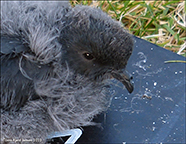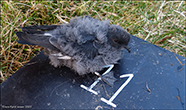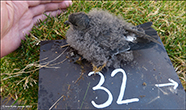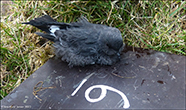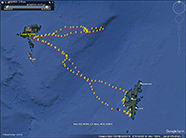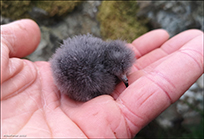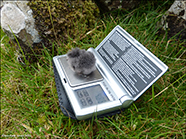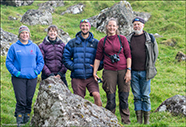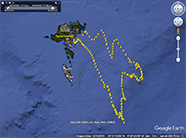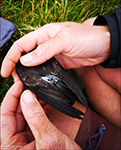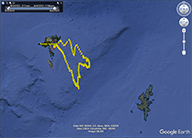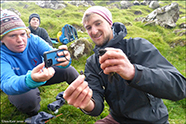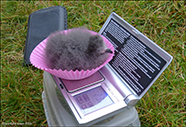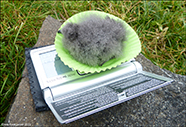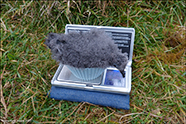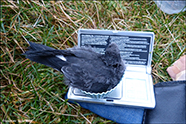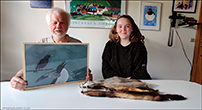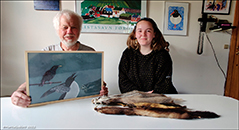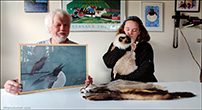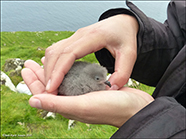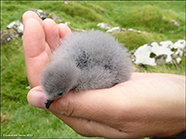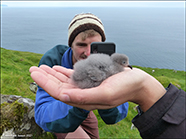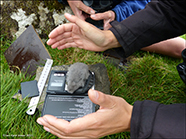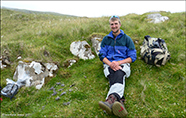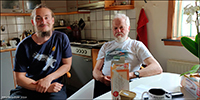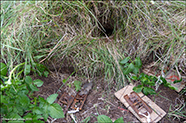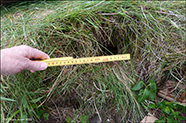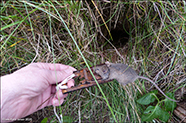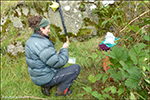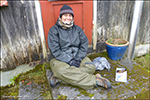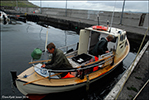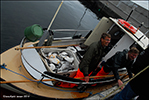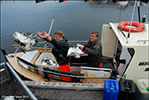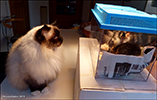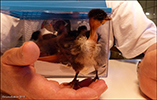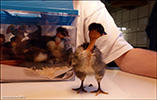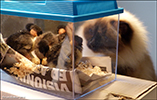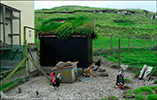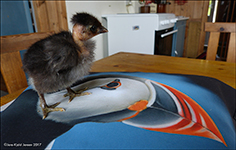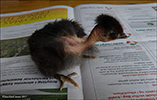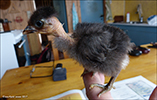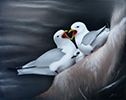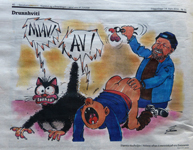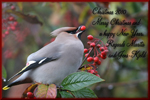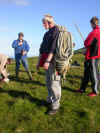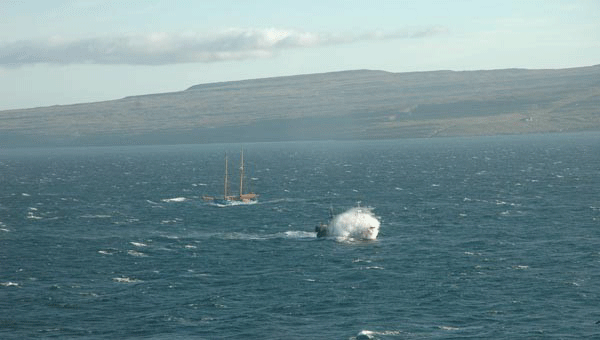| Blog from Rebecca Cheape about the European Storm Petrels in Nólsoy | |||
| _____________________________________________________________________________________ | |||
European Storm Petrels with a chick in the bird colony in Nólsoy, Faroe Islands 17.09.2024 |
|||
| When one of the parent birds comes home with food for the chick, the pair of Little Storm Petrel chatter and cuddle the chick, before the other parent bird flies back out to sea to look for more food. | |||
The footage is of course done without harming the birds in any way. |
|||
| ______________________________________________________________________ | |||
| The study of European Storm Petrel Hydrobates pelagicus is continuing in 2024 | |||
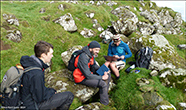 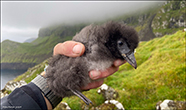 |
|||
The first photo is of Ben Porter and two of his work colleagues who are doing research in Urðin on Nólsoy. The next picture is of a fat Puffin chick, which has moved into a nest box, intended for Storm petrels. The picture was taken in Nólsoy on 28.07.2024, and on 14. August the Puffin chick was still in the nest box. |
|||
Photo: Ben Porter |
|||
| ______________________________________________________________________ | |||
The study of European Storm Petrel Hydrobates pelagicus is continuing in 2023 |
|||
| On November 24, 2023, the last Stormpetrel young had left the nest box. It will be very exciting to follow their journey in the coming years. | |||
October/November 2023: An adult European Storm Petrel weighs 26 g on average. The heaviest young in the colony in Nólsoy in 2023 weighed 54 g., when the parents thought it was capable to take care of itself. |
|||
| ______________________________________________________________ | |||
Nólsoy 09.09.2023. Team pictured (left to right): Jógvan Thomsen, Faroe Islands, Anne Ausems, Holland, Anna K. Znój, Polen, Rob Thomas, Wales, Zoe Deakin, Wales, Jade Philips, Wales, Jens-kjeld Jensen, Faroe Islands, Mark Bolton, Scotland and Ben Porter Wales.
|
|||
In 2023, Ben Porter has been granted support for his PhD project at Nólsoy from the Faroese Research Council in collaboration with the Faroese Environment Agency. In this connection, he must use nest boxes. Jens-Kjeld Jensen and Jógvan Thomsen have made the nest boxes, and in this connection the people in the photograph have been to Nólsoy this summer. Anne Ausems also has a smaller project again with the Storm Petrels in the colony on the island. |
|||
| The 72 nest boxes have been very successful, and only a very few of them have not been visited by Storm Petrels in the summer of 2023. | |||
Five Storm Petrels had a GPS tag attached to their tail, and above you can see what one of them did after the logger was attached. First, it flew a short trip directly to the east, which took a day. Then it flew back home to feed the young, it took approximately 10 minutes. Then it flew a trip of 350 km. to Shetland, which took 2 days. It was thus on the wings for 3 days. |
|||
| ______________________________________________________________ | |||
| The study of European Storm Petrel Hydrobates pelagicus is continuing in 2022 | |||
| Nólsoy 22.08.2022: The first Storm Petrel chick, that hatched in one of the nest boxes this year, weighed 4.8 g when it was 2-3 days old. The man weighing the chick is Ben Porter. | |||
| Read more about this study further down the page. | |||
| Mini-GPS-trackers on Storm petrels - Kringvarp Føroya |
|||
| ______________________________________________________________ | |||
Cooperation between the Faroese Enviromental Agency and the University in Cardiff |
|||
12. September 2022: So far, 6 Storm petrel chicks have hatched in our nest boxes, and there are also 6 eggs that have not yet hatched. There is a possibility that other Storm petrels will also lay eggs in several of the other nest boxes. |
|||
| Hannah Hereward, Cardiff University. Lauren Evans, Scotland. Ben Porter, Cardiff University, Anne Ausems, Holland & Jens-Kjeld Jensen. | |||
The route of the bird. Directly 160 km. to the Shetland Islands, where it fished for the first time. After 2 days and having flown a total of 600 km, it was back in the nest to feed the young. |
|||
| Field work | |||
| Storm petrel chick | |||
Each chick is weighed in its own muffin form, which is used only for it . This is to avoid any kind of infection between the Storm petrels in the colony at Nólsoy. |
|||
Videos |
|||
The Storm petrel returns to the nest and the chick |
|||
| ______________________________________________________________ | |||
| Suðuri í Dølum 16.10.2022 | |||
| In the photograph on the left, which was taken on September 12, the Storm Petrel chick weighed 9 grams. In the photograph on the right, which was taken today - October 16, the chick weighed 41.5 grams. | |||
Nólsoy 05.11.2022: Today the last Storm Petrel chick had left the nest boxes Suðuri í Dølum. On November 1, 2022, the chick weighed 42.3 g, so we hope it will make the trip to South Africa. |
|||
| Present from Ýr Ákadóttir | |||
| Jens-Kjeld Jensen & Ýr Ákadóttir | |||
| 21.08.2022 we were visited by one of the Faroe Islands' best artists, sweet Ýr, who brought us a very beautiful gift. The painting is of a starling and an alk, and as Jens-Kjeld remarked, this is probably the first time he has seen a painting where the color nuances in the white on the alk's chest could be clearly seen. | |||
| Ýr Ákadóttir is blessed with a great talent and it is a joy to see the details in her paintings. We look forward to seeing her future achievements. | |||
| Documentary about Jens-Kjeld in 2 parts. | |||
| The recordings are from June, sent in Kvf November 2021 | |||
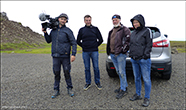 |
|||
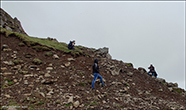 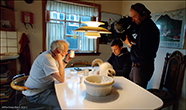 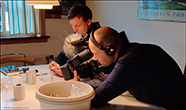 |
|||
| Part 1 |
|||
| Part 2 |
|||
| Study of European Storm Petrel Hydrobates pelagicus | |||
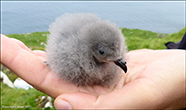 |
|||
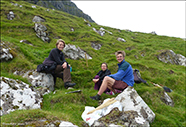 |
|||
Anne Ausems, Alexandra Fink & Ben Porter 04.09.2021 |
|||
| As all children, the European Storm Petrel chick must be weighed and measured | |||
A group of researchers from Wales, the Netherlands and Germany have together with Jens-Kjeld Jensen and Jógvan Thomsen since early in the summer 2021 been in Nólsoy examining the European Storm Petrel. There are several pilot projects, such as - where does the European Storm Petrel find its food? - is it influenced by the lights at the salmon farms? - and how will any planned offshore wind farm affect it? |
|||
| Update 16.09.2021 | |||
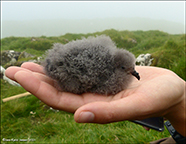 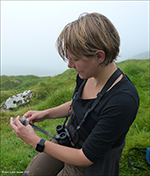 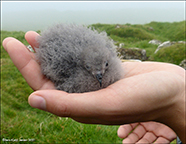 |
|||
The chick was about 14 days old when it was weighed on September 4, and then it weighed 24.7 g. When Anne Ausems weighed it again on September 16, it weighed 37.2 g |
|||
| Ben Porter 26.07.2021 | |||
Ben Porter is in the Faroe Islands working on a pilot project on light pollution from salmon rings, whether they disturb seabirds and so on. In that regard, he puts GPS loggers on some European Storm Petrels and possibly also Manx Shearwaters to find out, where they are searching for food. |
|||
The project will be focused on investigating how nocturnal seabird species such as European Storm Petrel and Manx Shearwater interact with light pollution around the north-east Atlantic, how their feeding areas overlap with marine development at sea, and how seabirds interact with fish farming. |
|||
| The website of Ben Porter |
|||
| Johan Henrik Funder Castenschiold & Jens-Kjeld Jensen, Tórshavn 13.06.2021 | |||
Johan Henrik Funder Castenschiold is in the Faroe Islands to do a pilot project of counting Fulmars, Arctic tern and Common Snipes using a drone. His pilot project is intended to result in a PhD. study next summer. |
|||
| MOUSE WITH GREATNESS MADNESS | |||
| Nólsoy 04.07.2020: When we observed this large hole with a diameter of 10 cm straight south of the village of Nólsoy, we were in no doubt - it had to be either a rat or a mink, which had settled down, since the grass was stepped completely flat at the entrance. The Rat Snap Trap was emptied several days in a row and it was also triggered several times. But after 5 days, we finally managed to catch this mouse with obvious greatness madness in an ordinary mousetrap. | |||
| Anne Ausems, Tórshavn 28.07.2019 | |||
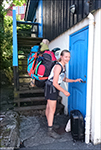 |
|||
The very talented Dutch scientist Anne Ausems was in the Faroe Islands in 2018 and 2019, and now she has written an article, where she compares the moulting of 2 different species of Faroese Storm-petrels with 2 species from Antarctica. |
|||
| Sophie Blohberger & Jens-Kjeld Jensen, Tórshavn 13.05.2018 | |||
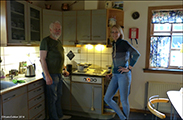 |
|||
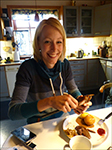 |
|||
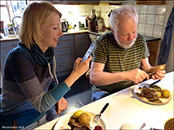 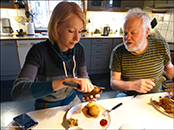 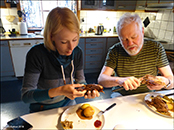 |
|||
| Sophie Blohberger is writing her Master Thesus about Faroese food culture, and how it affects the Faroese identity. | |||
| The Other Story | |||
| 19.02.2017 | |||
| For the past 4 decades, Jens Jensen has gone, day in and day out, exploring and studying the decaying Faroe islands wildlife. Away from the Grind (pilot whales slaughter) controversy, he relentlessly works towards a better and more sustainable future for his islands. | |||
Film about Jens-Kjeld, produced by Maxime and Francois Tornier |
|||
STUDIES OF MIGRATING BIRDS IN NÓLSOY |
|||
| Nólsoy 12.09.2016 | |||
| The biologist Katherine Rachel Scotchburn Snell is a PhD Student at the Natural History Museum in Copenhagen and is interested in the physiology of migration and is investigating blood chemistry of naturally displaced migrant birds. Biologist Rebecca C. Young, a postdoc at UNAM, Mexico, helps Katherine with catching and sampling. | |||
| ___________________________________________ | |||
STUDIES OF FULMAR CHICKS ON NÓLSOY |
|||
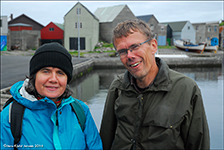 |
|||
| Åse & Bjørn Herrmann | |||
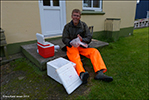 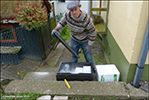 |
|||
Many foreign scientists are visiting Nólsoy during the years |
|||
| Bjørn Herrmann visited Nólsoy 17 years ago when the islanders took fulmar chicks. He wanted to find out, whether the Chlamydophila psittaci in the Faroese Fulmar chicks had weakened. Bjørn went along with the islanders in their boats, so that he could take the samples from the birds on the spot. | |||
| In August 2016, Bjørn Herrmann has visited Nólsoy again with his wife and Patrik Ellstrøm, which is also a microbiologist. This time they will examine the Fulmar chicks for Campylibactor, bird flu and psittacosis. | |||
| It will be very exciting to see the results of their investigations. | |||
| Thanks to Virgar Joensen, Marnar á Skúr and Juul Margeir Jacobsen for having the Swedes on their boats. | |||
Read article from 2006 about Chlamydophila psittaci in Faroese Fulmar chicks |
|||
| 12.07.2015 | |||
| A new generation Sibenbürgen chickens have seen the light of day | |||
 |
|||
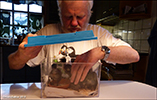 |
|||
| Our hen house on Nólsoy | |||
| One of our chickens in July 2017 | |||
| Present from Dawid Kilon | |||
| This amazing drawing is a present from the Polish biologist Dawid Kilon, who also is the artist. | |||
Visit his blog on: rysunekprzyrodniczy.blogspot.com |
|||
| Drawing by Óli Petersen in Sosialurin 14.03.2014 | |||
Nólsoy became Ramsar area 06.07.2012 and according to Jens-Kjeld cats are the biggest threat - that is after the man! |
|||
| Nathusius’s Pipistrelle Bat Pipistrellus nathusii found on Nólsoy 16.01.2010 | |||
| 16. januar 2010 Mikkjal Holm found an almost dead Nathusius’s Pipistrelle Bat hanging on the wall of the grocery Matvørubúðin, owned by Hervør Hansen, Nólsoy. It was a male with the weight of only 5.5g. This is the second Nathusius’s Pipistrelle Bat ever found in the Faroes in January - the first was found in Sumba, Suðuroy 09.01.1992. | 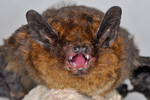 |
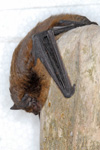 |
|
| Bats are seen in the Faroe Islands the whole year except from in April. | |||
The men from Nólsoy went to hunt hares
07. November 2009 |
|||
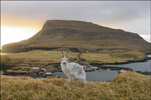 |
|||
In 2009 the annual day for hunting hares was 07. November. 22 men participated and they shot 50 hares. We met as usually at kl. 08 at the local fire station. The weather was very fine in the morning, but already kl. 09.30 it started dripping from above and an half hour later it rained heavy. Kl. 12.30 it was blowing heavily from Northeast. In spite of the very bad weather 50 hares were shot in 99 shots. The best marksman that day was Búgvi Jacobsen, who shot 7 hares in 7 shots. |
|||
Hunting on Nólsoy |
|||
 |
It is a common practice to shoot young Great Black-backed Gulls for dinner in Nólsoy. Unusually many were seen the last 14 days of September 2007, and 25. Sep. Ivan and Mikkjal Holm shot as many as 64 birds, which most probably must be the highest amount ever shot in only one day in Nólsoy |  |
|
In the summer of 2006 the fabulous artist Olivier Kugler traveled from Shetland to Faroe Islands, Iceland and USA and ended in Cuba. While he was in Faroe Islands he made some marvellous sketches with motives from for example Hattarvík and Nólsoy, which have been printed in The Guardian. You can see 32 different pages with his sketches from his journey here: http://www.olivierkugler.com/travel/ Remember to use the F11 button on the keyboard to be able to turn the pages. |
 |
||
The men from Nólsoy went to hunt hares
22. November 2008 |
|||
In 2007 the annual hunt for hares was 03. November. The weather was absolutely perfect that day. 27 men participated and they shot 69 hares. On average they used 3 shots on each hare, and the best marksman that day was Mikkjal Holm, who got 4 hares with 4 shots. The average weight of the hares was 2758 g, and the heaviest was a female, with a weight of 3275 g. |
|||
|
|
||
|
The hunters from Nólsoy caught Fulmar young ones 19.08.05 |
||
THE ANNUAL HUNT FOR FULMAR YOUNG ONES ON NÓLSOY |
||
|
A normal catch would have been app. 50 young ones, but this time only 43 young ones were taken. Furthermore 10 of the nests were empty, although there were traces of small feathers. A hunting number of 43 young ones in total is not that bad, but that was the only positive thing! Perhaps 6-7 young ones would have been fledged in app. 1 week, and 5-7 probably in 14 days. The others were so small and miserable, that they would never have been able to get that far – they would have been dead! I believe, that the young ones from the 10 empty nests have died (from starvation?); where after gulls and other hungry birds have eaten them. I have not seen anything like this in the last 15 years, and if the situation is the same throughout the Faroes, then the hunt for young ones on the sea - which is about to start, will be very limited! |
||
|
|
||
|
The view from our kitchen window at appr. 6.30 p.m. |
||
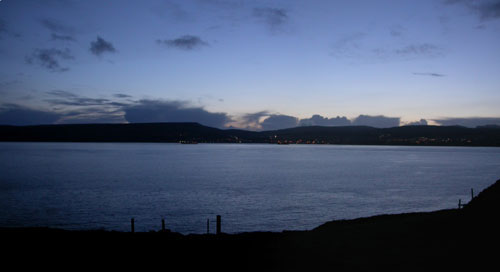
|
||
|
|
||
|
Summer in Nólsoy |
||
|
|
||
|
|
||
|
Winter in Nólsoy |
||
|


